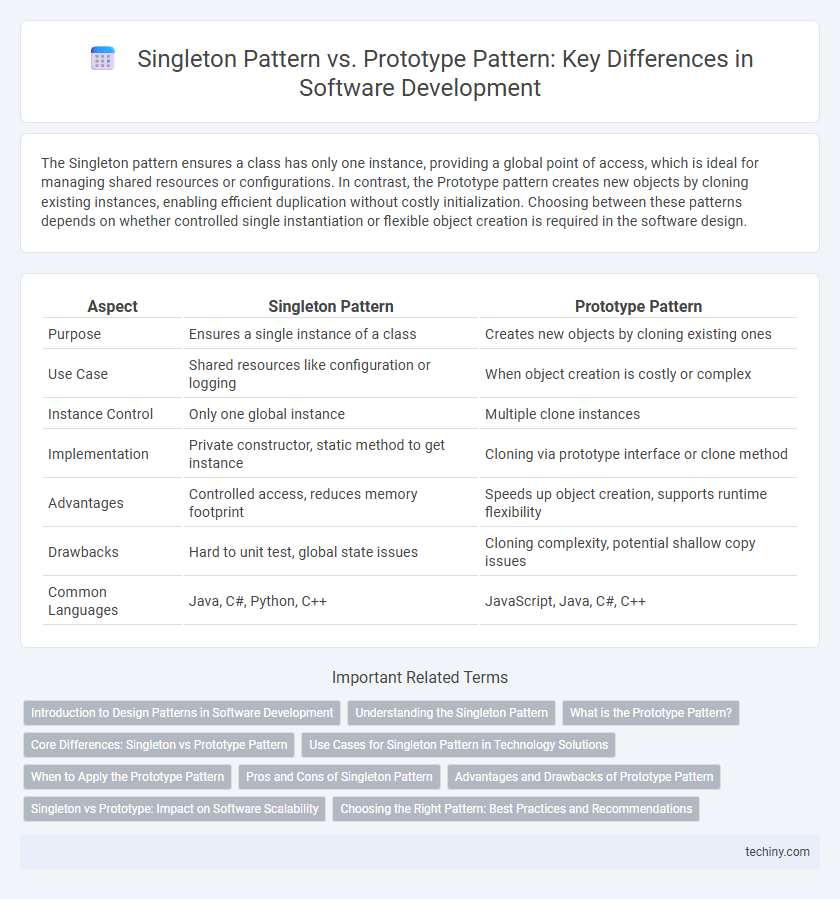The Singleton pattern ensures a class has only one instance, providing a global point of access, which is ideal for managing shared resources or configurations. In contrast, the Prototype pattern creates new objects by cloning existing instances, enabling efficient duplication without costly initialization. Choosing between these patterns depends on whether controlled single instantiation or flexible object creation is required in the software design.
Table of Comparison
| Aspect | Singleton Pattern | Prototype Pattern |
|---|---|---|
| Purpose | Ensures a single instance of a class | Creates new objects by cloning existing ones |
| Use Case | Shared resources like configuration or logging | When object creation is costly or complex |
| Instance Control | Only one global instance | Multiple clone instances |
| Implementation | Private constructor, static method to get instance | Cloning via prototype interface or clone method |
| Advantages | Controlled access, reduces memory footprint | Speeds up object creation, supports runtime flexibility |
| Drawbacks | Hard to unit test, global state issues | Cloning complexity, potential shallow copy issues |
| Common Languages | Java, C#, Python, C++ | JavaScript, Java, C#, C++ |
Introduction to Design Patterns in Software Development
The Singleton Pattern ensures a class has only one instance and provides a global access point, ideal for managing shared resources like configuration settings or logging. The Prototype Pattern enables object creation by cloning existing instances, promoting flexibility and reducing the overhead of repeated initialization in complex objects. Both patterns address object creation challenges but serve different purposes: Singleton controls instance count while Prototype facilitates object duplication in software design.
Understanding the Singleton Pattern
The Singleton Pattern ensures a class has only one instance while providing a global access point to it, optimizing resource management and consistency across software systems. It is commonly implemented using lazy initialization or thread-safe mechanisms, making it crucial for scenarios like logging, configuration settings, or database connections. Understanding the Singleton Pattern enhances design efficiency by avoiding redundant object creation and maintaining controlled access to shared resources during software development.
What is the Prototype Pattern?
The Prototype Pattern in software development is a creational design pattern that allows objects to be cloned from an existing instance rather than created from scratch, facilitating efficient object creation and flexibility. It enables developers to create new objects by copying a prototype instance, which is particularly useful when instantiation is resource-intensive or complex. This pattern contrasts with the Singleton Pattern, which restricts a class to a single instance, while the Prototype Pattern supports multiple cloned objects.
Core Differences: Singleton vs Prototype Pattern
The Singleton pattern ensures a class has only one instance, providing a global point of access to that instance, which is crucial for resource management and controlled access in software development. In contrast, the Prototype pattern creates new objects by cloning existing instances, facilitating object creation with complex configurations without the overhead of instantiating from scratch. Core differences lie in instance control--Singleton restricts to one unique instance, while Prototype enables flexible object duplication for dynamic and scalable applications.
Use Cases for Singleton Pattern in Technology Solutions
Singleton Pattern is ideal for managing shared resources such as database connections, configuration settings, and logging systems where a single instance ensures consistent access and reduces resource overhead. It is commonly used in application-wide services, caching mechanisms, and thread pools to maintain controlled access and state integrity. The pattern's effectiveness in enforcing a global point of access makes it suitable for scenarios demanding centralized control and coordination.
When to Apply the Prototype Pattern
The Prototype Pattern is ideal when creating new instances by cloning existing objects is more efficient than constructing them from scratch, especially in complex object configurations or costly initializations. It suits scenarios requiring numerous identical objects with slight variations, enabling rapid object creation while preserving memory and computing resources. This pattern excels in applications involving dynamic runtime object creation, like graphical editors or simulation environments.
Pros and Cons of Singleton Pattern
The Singleton Pattern ensures a single instance of a class, simplifying resource management and maintaining global state consistency in software development. It can reduce overhead by limiting object creation, but this tight control often introduces issues with unit testing, concurrency, and scalability in multithreaded environments. Overuse of Singletons can lead to hidden dependencies and hinder code maintainability compared to more flexible patterns like Prototype.
Advantages and Drawbacks of Prototype Pattern
Prototype Pattern enables efficient object creation by cloning existing instances, reducing the cost of creating complex objects and improving performance in scenarios with frequent duplication. It offers flexibility by allowing dynamic object configuration without subclassing, but managing clone consistency and deep copying can introduce complexity and potential bugs. Prototype Pattern may increase memory usage due to storing prototype instances and requires careful implementation to avoid issues with mutable shared state.
Singleton vs Prototype: Impact on Software Scalability
Singleton pattern restricts class instantiation to a single object, limiting flexibility and potentially creating bottlenecks in high-load, scalable environments. Prototype pattern enables cloning of objects to create new instances efficiently, supporting better scalability by allowing concurrent object creation without shared state constraints. This difference significantly impacts software scalability, where prototype pattern favors distributed and parallel processing architectures compared to the singleton's centralized access control.
Choosing the Right Pattern: Best Practices and Recommendations
When choosing between Singleton and Prototype patterns in software development, consider the need for instance control versus object cloning. Singleton ensures a single shared instance, ideal for managing global state or resources like configuration settings, while Prototype supports creating new objects by cloning existing ones, beneficial for performance in scenarios requiring many similar objects. Best practices recommend using Singleton for consistent state management and Prototype when object creation cost is high or customization per instance is necessary.
Singleton Pattern vs Prototype Pattern Infographic

 techiny.com
techiny.com